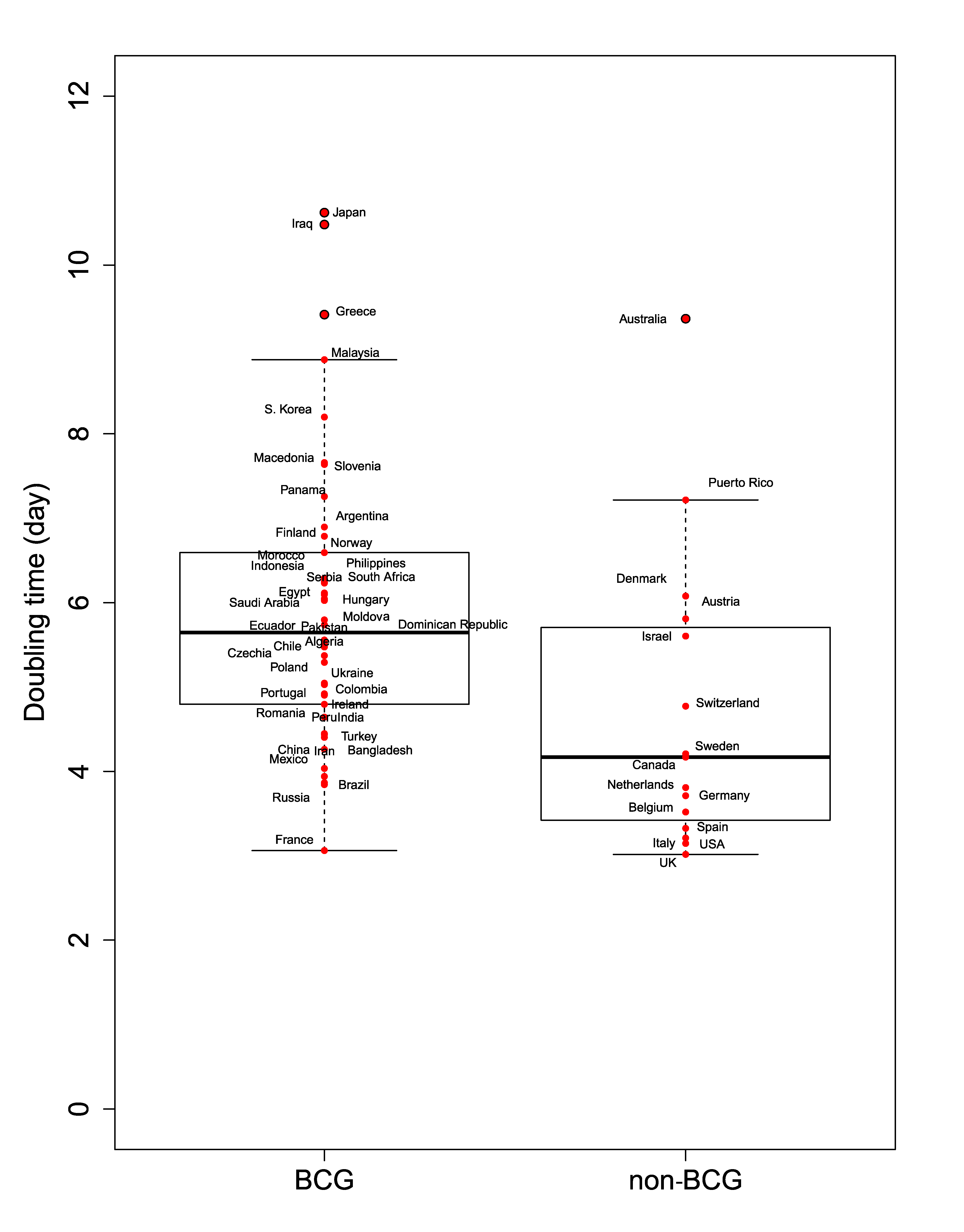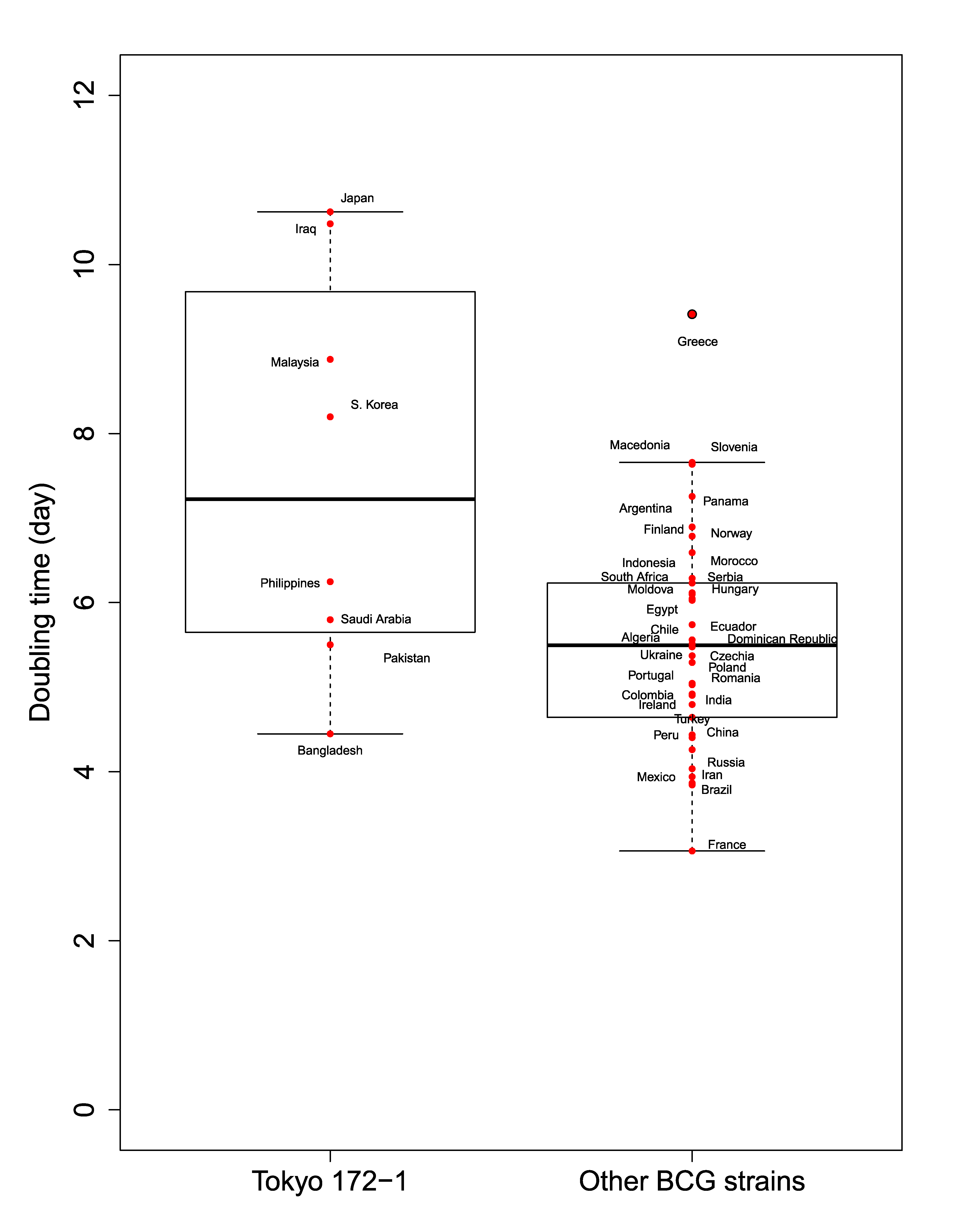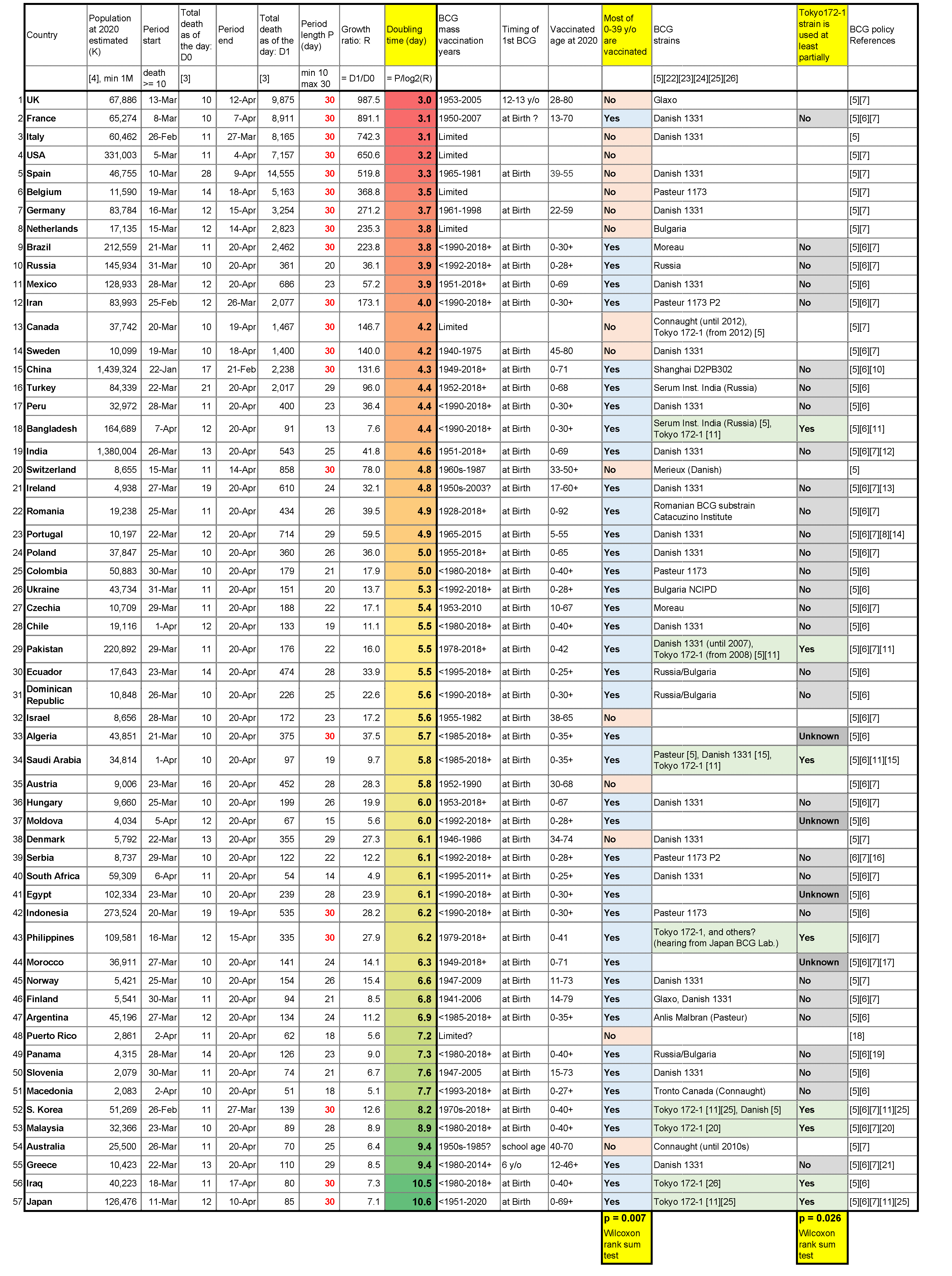Relationship between COVID-19 death toll doubling time and national BCG vaccination policy
Yutaka Akiyama* and Takashi Ishida (*Email: akiyama(at)c.titech.ac.jp)
Department of Computer Science, School of Computing, Tokyo Institute of Technology
W8-76 2-12-1 Ookayama, Meguro-ku, Tokyo 152-8550, Japan
medRxiv 2020.04.06.20055251; DOI: 10.1101/2020.04.06.20055251
Abstract
In this manuscript, we showed a statistically significant difference of the doubling times of the death toll between the group of countries with national universal Bacillus Calmette-Guerin (BCG) vaccination and the group without it for recent years. Based on a statistical test, the distributions of the doubling time of these two groups were significantly different (p = 0.007). Miller et al. reported the relationship between BCG vaccination and mortality for COVID-19 based on deaths per million inhabitants. However, they did not take into account the differences in COVID-19 detection rates among the countries and the epidemic stages of the countries. Therefore we used a doubling time of the death toll as a more stable indicator instead. We also investigated the dependency of the BCG strains. Among the 42 BCG-vaccinated countries, the median doubling time of the eight countries using "Tokyo 172-1" strain at least partially (Japan, Iraq, Malaysia, South Korea, Philippines, Saudi Arabia, Pakistan, and Bangladesh) was 7.2 days, and that of the other 34 vaccinated countries was 5.5 days. Their distributions were also significantly different (p = 0.026).
The non-specific effects of Bacillus Calmette-Guerin (BCG) vaccination have been enthusiastically discussed [1]. Miller et al. reported the relationship between BCG vaccination and mortality for COVID-19 based on deaths per million inhabitants [2]. However they did not take into account the differences in COVID-19 detection rates among the countries and the epidemic stages of the countries. Therefore we used a doubling time (DT) of the death toll as a more stable indicator.
First, we investigated the DT of COVID-19 deaths in 57 countries (source: Our World in Data [3], as of 20 April 2020). We defined the baseline date of each country as the date when summed fatalities of at least ten people was first observed in the country. We covered all countries that have at least 10-day observation period and had a population [4] of more than 1 million. To exclude the effect of social interventions, the death toll data of the country was truncated by 30 days after the baseline date (for 20 countries among 57).
Next, we surveyed the national BCG vaccination policies of each country (sources: BCG Atlas [5], WHO-UNICEF report [6], and other 20 papers [7-26]). The 57 countries were divided into two groups based on whether the majority of the population between the ages of 0 and 39 was vaccinated ("BCG") or not ("non-BCG"). BCG vaccination records, especially cover rates, are reliable only for the last few decades for several countries. The BCG policy data collected as well as calculated DTs for 57 countries are shown in Table 1.
Figure 1 shows the distributions of DTs. Most of DTs for 42 "BCG" countries are longer than 15 "non-BCG" countries (the medians of the DTs are 5.6 days and 4.2 days, respectively.) The variance of DTs of "BCG" countries was almost same as that of "non-BCG" (σ = 1.7 and σ = 1.8, respectively.) Based on a Wilcoxon rank-sum test, the distributions of these two groups were significantly different at the significance level of 0.05 (p = 0.007).
We also investigated the dependency of the BCG strains (Figure 2). Among the 42 "BCG" countries, the median DT of the eight countries using "Tokyo 172-1" strain at least partially (Japan, Iraq, Malaysia, South Korea, Philippines, Saudi Arabia, Pakistan, and Bangladesh) was 7.2 days, and that of the other 34 vaccinated countries was 5.5 days. The variance of DTs of "Tokyo 172-1" countries was large (σ = 2.4) while DTs of "other BCG strains" are relatively concentrated (σ = 1.3). Their distributions were also significantly different at the significance level of 0.05 (p = 0.026).
We showed a statistically significant difference of the doubling times of the death toll between "BCG" and "non-BCG" countries. However, the correlation might be spurious and does not directly imply causality. In addition, we should carefully take the suggested difference between BCG strains, because the number of samples are not enough and some countries are using mixed strains.
Figures and Table

Figure 1. The death toll doubling time (DT) of BCG vaccinated ("BCG") and non-vaccinated ("non-BCG") countries

Figure 2. The death toll doubling time (DT) of Tokyo 172-1 ("Tokyo 172-1") and other BCG strains ("Other BCG strains") countries
Table 1. The COVID-19 death toll doubling time and the national BCG vaccination policy of 57 countries.

References
-
Moorlag SJCFM, Arts RJW, van Crevel R, Netea MG. Non-specific effects of BCG vaccine on viral infections. Clin Microbiol Infect 2019; 25(12):1473–1478.
https://doi.org/10.1016/j.cmi.2019.04.020 -
Miller A, Reandelar MJ, Fasciglione K, Roumenova V, Li Y, Otazu GH. Correlation between universal BCG vaccination policy and reduced morbidity and mortality for COVID-19: an epidemiological study. medRxiv, 2020.03.24.20042937.
https://doi.org/10.1101/2020.03.24.20042937 -
Total deaths. Coronavirus Source Data. Our World in Data. Global Change Data Lab. (Release 20 April 2020).
https://ourworldindata.org/coronavirus-source-data (last accessed 20 April 2020) -
World Population Prospects 2019. File POP/1-1: Total population (both sexes combined). The United Nations 2019.
https://population.un.org/wpp/Download/Standard/Population/ (last accessed 20 April 2020) -
BCG Atlas (2nd Edition) - A Database of Global BCG Vaccination Policies and Practices.
http://www.bcgatlas.org (last accessed 20 April 2020) -
WHO-UNICEF estimates of BCG coverage (1-July-2019). World Health Organization. 2019.
https://apps.who.int/immunization_monitoring/globalsummary/timeseries/tswucoveragebcg.html (last accessed 20 April 2020) -
"BCG Vaccine" (English version). Wikipedia: The Free Encyclopedia.
https://en.wikipedia.org/wiki/BCG_vaccine (last accessed 20 Apr. 2020) -
The organization and delivery of vaccination services in the European Union. European Observatory on Health Systems and Policies. 2018.
https://ec.europa.eu/health/sites/health/files/vaccination/docs/2018_vaccine_services_en.pdf (last accessed 20 Apr. 2020) -
Infuso A, Falson D. European survey of BCG vaccination policies and surveillance in children, 2005. Euro Surveill 2006; 11(1-3).
https://www.eurosurveillance.org/upload/site-assets/imgs/2006%201%20v06n01.pdf -
Chen ZR, Wei XH, Zhu ZY. BCG in China. Chin Med J 1982; 95(6):437-442.
https://www.ncbi.nlm.nih.gov/pubmed/6813052 -
Joung SM, Ryoo S. BCG vaccine in Korea. Clin Exp Vaccine Res 2013; 2(2):83-91.
https://www.ncbi.nlm.nih.gov/pmc/articles/PMC3710928/ -
Lahariya C. A brief history of vaccines & vaccination in India. Indian J Med Res. 2014; 139(4):491-511.
https://www.ncbi.nlm.nih.gov/pmc/articles/PMC4078488/ -
Sweeney E, Dahly D, Seddiq N, Corcoran G, Horgan M, Sadlier C. Impact of BCG vaccination on incidence of tuberculosis disease in southern Ireland. BMC Infect Dis 2019; 19(397).
https://doi.org/10.1186/s12879-019-4026-z -
Rodrigues EF, Leite A, Cabral M, Duarte G, Marques AP, Cale E, et al. Local Tuberculosis Georeference: a tool to define BCG vaccination in high-incidence area in Portugal. Eur J Public Health 2019; 29(4).
https://doi.org/10.1093/eurpub/ckz186.532 -
Jumaah SA, Hajjar SA, Mousa HA. Bacille Calmette-Guérin Vaccination in Saudi Arabia: Benefits versus Risks. Ann Saudi Med 2012; 32(1):1–3.
https://www.ncbi.nlm.nih.gov/pmc/articles/PMC6087653/ -
Pesut D. Contemporary status of BCG vaccine in the world and in Serbia. Med Pregl 2004; 57(Suppl 1):37-40.
https://www.ncbi.nlm.nih.gov/pubmed/15686220 -
Gaud J. BCG Vaccination in Morocco. Maroc Medical 1954; 33(352):852-59.
https://www.cabdirect.org/cabdirect/abstract/19552702408 -
Dirlikov E, Thomas D, Yost D, Tejada-Vera B, Bermudez M, Joglar O, et al. Tuberculosis Surveillance and Control, Puerto Rico, 1898–2015. Emerg Infect Dis 2019; 25(3):538-546.
https://dx.doi.org/10.3201/eid2503.181157 -
De Pinzon TP. BCG Vaccination in the Republic of Panama. Am Rev Tuberc 1953; 67(4):522–525.
https://www.atsjournals.org/doi/abs/10.1164/art.1953.67.4.522 -
Govindarajan KK, Chai FY. BCG Adenitis - Need for Increased Awareness. Malays J Med Sci 2011; 18(2):66–69.
https://www.ncbi.nlm.nih.gov/pmc/articles/PMC3216207/ -
Tina L, Lamprakou M, Andriopoulos P. Mantoux test and BCG vaccination in elementary schools in Lakonia, Greece 2005-2015. Eur Respiratory J 2016; 48:PA2742.
https://doi.org/10.1183/13993003.congress-2016.PA2742 -
Behr MA, Small PM. A historical and molecular phylogeny of BCG strains. Vaccine 1999; 17(7-8):915-922.
https://doi.org/10.1016/S0264-410X(98)00277-1 -
Cernuschi T, Malvolti S, Nickels E, Friede M. Bacillus Calmette-Guérin (BCG) vaccine: A global assessment of demand and supply balance. Vaccine 2018; 36(4):498-506.
https://doi.org/10.1016/j.vaccine.2017.12.010 -
The SAGE Working Group on BCG Vaccines and WHO Secretariat. Report on BCG vaccine use for protection against mycobacterial infections including tuberculosis, leprosy, and other nontuberculous mycobacteria (NTM) infections. 2017.
https://www.who.int/immunization/sage/meetings/2017/october/1_BCG_report_revised_version_online.pdf (last accessed 20 April 2020) -
Jou F, Huang WL, Su WJ. Tokyo-172 BCG Vaccination Complications, Taiwan. Emerg Infect Dis 2009; 15(9):1525-1526.
https://doi.org/10.3201/eid1509.081336 -
Ritz N, Curtis N. Mapping the global use of different BCG vaccine strains. Tuberculosis 2009; 89(4):248-251.
https://doi.org/10.1016/j.tube.2009.03.002
Supplementary data
The excel file of Table 1 is available here